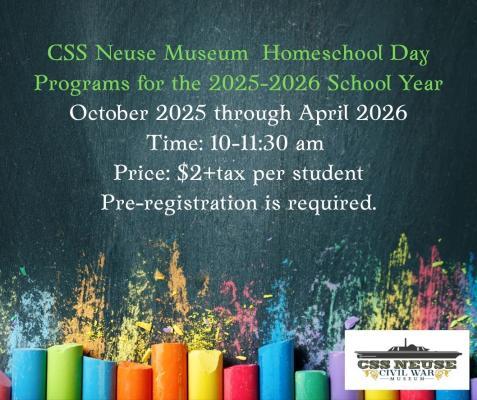Field Trip to the CSS Neuse Museum
Program Objectives
1. Students should understand the importance of the CSS Neuse and how its story fits into the overall story of the Civil War in eastern North Carolina.
2. Students should understand the importance of the technological advancements of the mid-nineteenth century regarding the advent of rifled artillery and the development of ironclads.
3. Students should have a basic understanding of shipbuilding practices and the efforts it took to build the CSS Neuse.
4. Students should clearly understand what life was like in Kinston, North Carolina, during the Civil War, for the soldiers and sailors stationed there and for the civilians living in this area.
Field Trip Registration and Pre-Visit Activities
Registration Form: https://tinyurl.com/3eat97d2
Educator Guide: https://tinyurl.com/pdtby3hs
Educator Field Trip Survey: https://forms.office.com/g/ZPvR0c9Fy6
1. Teachers may use the Supplemental Lesson Plan: Life Onboard an Ironclad as a pre-visit activity or a stand-alone classroom lesson. Classes preparing for a field trip to the site should familiarize themselves with the two diagrams of the ship found in this lesson and the Glossary of Terms before their visit.
2. Check out some of the videos on our YouTube channel.
On-Site Activities
The core on-site program lasts 1.5 hours and is customizable. Generally, groups will begin by watching the orientation film, followed by a grade-level-appropriate scavenger hunt, and then engage in one to two activities, depending on the time and size of the group. Please allow time for bathroom breaks, gift shop sales, and transitions between stations in your planning. Every effort will be made to satisfy your requests. However, staff reserves the right to alter planned programming due to unanticipated staff shortages.
1. CSS Neuse Orientation Film – This film is 10 minutes long and gives an overview of the history of the CSS Neuse from design and construction through the recovery in the 1960s.
2. Scavenger Hunt- Each scavenger hunt is colorful and full of graphics. The suggested K-2 scavenger hunt has items or images that the students must find in the museum. Our other scavenger hunt requires each group of students to read, answer questions, complete a word search, and more! Most groups spend 25-30 minutes completing the scavenger hunt.
3. Activities- Please review the Educator’s Guide to decide on the activities you would like for your students to participate in during their field trip. Most teachers select one to two activities, depending on the time and the size of the group.
Homeschool Families

The CSS Neuse Museum offers monthly homeschool day programs from September through April each year. Programs run from 10:00 to 11:30 am. Pre-registration is required. The activity fee is $2.00 plus tax per student. Ages 3 and under are free. If you cannot attend one of the homeschool day events, but you would still like to schedule a field trip to the CSS Neuse Museum, please email Rachel at rachel.kennedy@dncr.nc.gov.
October 2025-April 2026 Homeschool Day Programs
Join us for CSS Neuse Museum Homeschool Day programs for the 2025-2026 school year! After everyone has registered, our team will assign each student to a group for the field trip. Please ensure that you include the Co-op or group you would like to be with on the registration form. You can register for all the homeschool day programs at once or every month.
Dates and Themes:
October 8- Espionage
November 5- NC Ironclads and Civil War Weapons
December 17- Victorian Christmas
January 8- Environmental Education
February 12- NC History
March 12- Women's History
April 16- NC Government
For each of these programs, staff from other NC Historic Sites, other state agencies, volunteers, and nonprofit organizations will help create engaging and memorable experiences for your homeschool student(s). We're excited to include lots of hands-on activities to make learning fun. Each station will be around twelve minutes long, giving families a chance to explore several stations in organized groups.
The activity fee is $2.00 plus tax per student. Admission for parents, chaperones, and guardians is free, but everyone will still need to register. Ages 3 and under are free.
Registration link: https://tinyurl.com/y49amdu7
Registration will close on the Monday preceding the event date, allowing staff to organize groups and distribute the list by email. Registration will reopen after each homeschool day program is finished. If you have any questions, please email Rachel at rachel.kennedy@dncr.nc.gov.
Homeschool Prom - The Friends of the CSS Neuse Museum plan and host an annual Homeschool Prom. March 2025 marked their fourth year of offering a homeschool prom, and it drew 237 homeschoolers from all over North Carolina, as well as a few from Virginia.

March 21, 2026: Prom Registration
Homeschool Graduation - The Friends of the CSS Neuse Museum plan and host an annual homeschool graduation ceremony.

May 30, 2026: Homeschool Graduation Registration
Outreach
We also offer off-site visits to educators. If you are interested in discussing outreach options, please email Rachel at rachel.kennedy@dncr.nc.gov or call 252-526-9600 ext. 222.
Examples of past offsite visits to classrooms include:
-Presentation on the CSS Neuse and Shipbuilding Activity
-Presentation on Female Spies and Espionage Activity
-Life of a Civil War Soldier or Sailor
Documents
This page was last modified on 10/11/2025
